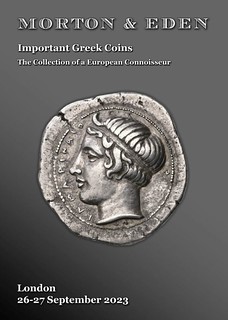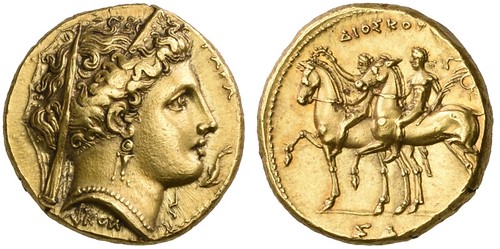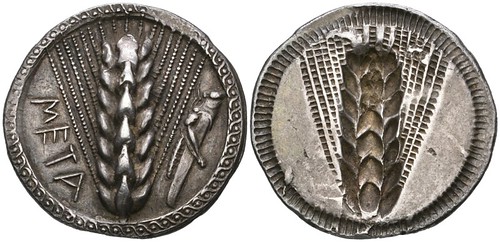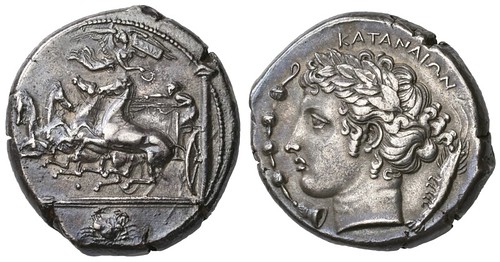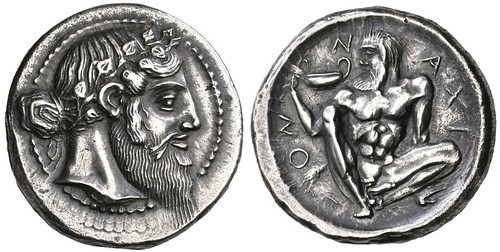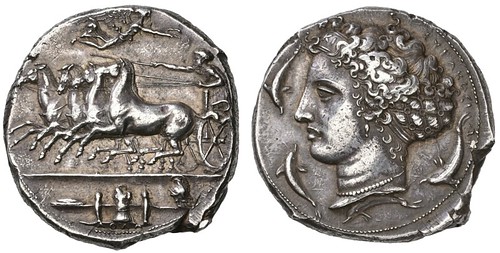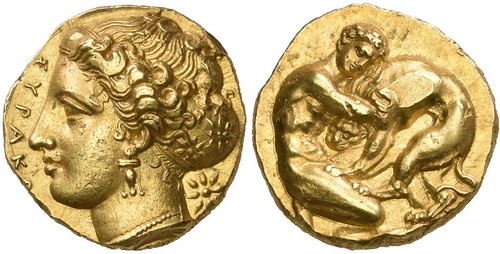
PREV ARTICLE
NEXT ARTICLE
FULL ISSUE
PREV FULL ISSUE
MORTON & EDEN SEPTEMBER 2023 GREEK SALEAn important collection of Greek Coins will be sold by Morton & Eden Ltd on 26-27 September. Here are a few selections. -Editor
Specialist Tom Eden said of the collection, ‘We are very excited about this collection which is probably the finest to appear on the market since the sale of the ‘Prospero' collection in New York in 2012, and both collectors and dealers are eagerly looking forward to the event'. Two major highlights are coins from 5 th century BC Sicily when the island was a Greek colony and part of what has come to be known as Magna Graecia. From the city of Naxos is a beautiful silver tetradrachm struck around 460 BC (lot 112, estimate £400,000-600,000). It used to be owned by Jean-Jacques Barre, Chief Engraver of the Paris Mint from 1842 to 1855, himself a celebrated designer and engraver who perhaps drew inspiration from this very coin. The style is transitional from archaic to classical and the example to be sold is one of the finest known of the few surviving specimens. The coin depicts the head of the wine god Dionysos on the obverse and his woodland companion, the drunken Silenos, on the reverse, both types which obviously celebrate a flourishing local viticulture. Coins of this type have long been greatly admired for the skill of the die engraver, named in modern times as the ‘Aetna Master' after a unique tetradrachm of Aetna in the Brussels Museum which was issued at the same period as the Naxos piece.
From Syracuse comes an exceptional silver dekadrachm struck around 405 BC, signed by
the celebrated artist Kimon. Described in 1927 by Sir George Hill as Ranging in date from the 6th to the 1st century BC, the collection includes coins from all over the Ancient Greek world from Spain in the West, around the whole of the Mediterranean region and then to Egypt and Cyrene in North Africa. Not all the pieces are expensive, with estimates ranging from as little as £100 to well over £100,000. Morton & Eden have produced a substantial printed catalogue and the entire sale can also be viewed online via Biddr.com, invaluable.com, numisbids.com and sixbid.com as well as at www.mortonandeden.com. Lot 25. Italy, Calabria, Tarentum, gold stater, c. 302 BC, ????, veiled female head right, wearing a necklace, triple-drop earring, and stephane decorated with a palmette and pellets; to right, dolphin swimming downwards; below truncation, ???, rev., ???S???[??], the Dioscuri, laureate, on horses pacing left; the nearer holds a palm with wreath and fillet, the farther crowning his horse with a wreath; in ex.,S?, 8.59g, die axis 7.00 Note: The hairstyle and physiognomy of the head (variously described as Hera, Persephone, or Amphitrite) though veiled and restrained, are derived from Euainetos's Syracusan dekadrachms of a century earlier, testament to their lasting influence. Whether struck as financial support for a campaign against growing Syracusan power or a threat from non-Italian tribes in the interior, this very rare gold issue was an emergency one to pay mercenaries. In 302 BC Tarentum appealed to its mother-city, Sparta, and its king, Klemoenes, for help. Portrayed on the reverse as victors in the games are the Dioscuri, Castor and Polydeuces (Pollox), the patron deities of both Tarentum and Sparta.
To read the complete lot description, see:
Lot 35. Italy, Lucania, Metapontum, stater, c. 540-500 BC, ????, ear of barley; in field right, grasshopper, rev., ear of barley incuse, 8.06g, die axis 12.00 (Noe/Johnston 103 and pl. VII = K. Schefold, Meisterwerke griechischer Kunst, Basel, 1960, 441, this piece; Gorini 10; AMB 130; HN Italy 1472), light grey toning, well-centred and extremely fine, very rare sacred to Apollo. Provenance: Rev. Percy Barron collection, J. Hirsch XXX, 11 May 1911, lot 166; Münze und Medaillen 75, 4 December 1989, lot 74 (enlarged pl. 18); Dr. Peter Suter collection, Münzen und Medaillen 89, 14 June 2000, lot 12 (colour pl. B); European Connoisseur collection (formed before 2002).Note: This incuse type, with the spread fabric, guilloche border, and subsidiary symbols (Noe class V) is ‘thought by some to be the highwater mark for the incuse coinage.' (Noe p. 21). sacred to Apollo. The grasshopper is rendered with naturalistic fidelity and it seems unlikely that it represents a magistrate's badge. Rather, the issue is more likely to have propitiatory or commemorative significance, as an offering to Apollo for protection, or deliverance from a plague of locusts. The obverse die is linked to those with a dolphin, which was sacred to Apollo.
To read the complete lot description, see:
Lot 89. Sicily, Katana, tetradrachm, c. 410 BC, signed by Euainetos, fast quadriga left passing a turning post; above, Nike flying right holding wreath to crown charioteer and tablet inscribed with the engraver's signature, ?????; in ex., crab, rev., ???????O?, laureate head of Apollo left; to right, crayfish; to left, bell at the end of knotted fillet, 17.01g, die axis 1.00 Charles Lenormant's opinion was not unique, a few of Euainetos's other admirers included B.V. Head, A.J. Evans and the ‘inventor' of art history, Johann Winkelmann. Euianetos signed the dies for remarkable coins from Syracuse, Kamarina and, as here, Katana. The depiction of the chariot on the obverse is perhaps his most exciting: the horses's legs churn madly, their heads tossing; the charioteer crouches forward intently urging on the horses, while pulling tightly at his reins to retain control; the chariot swings violently into three-quarter view as he makes his turn past the meta, while Nike (holding a tablet advertising the artist's name) hovers serenely above ready to crown the winner even before the races's end. The counterpoint to this drama is the calm head of Apollo, delicately modelled, his head framed by the city's name, and a fillet with a bell at its end and a crayfish which may allu
To read the complete lot description, see:
Lot 112. Sicily, Naxos, tetradrachm, c. 460 BC, attributed to the Aitna Master, bearded head of Dionysos right, crowned with ivy, his hair tied in krobylos at back of neck, rev., ?-???-??, Silenos, nude and ithyphallic, squatting on the ground, raising kantharos to his lips while supporting himself with his left arm, 16.88g, die axis 9.00 Universally celebrated for both its composition and execution, the Naxos tetradrachm attributed to the Aitna master is perhaps unique in that critics have historically judged it not merely by comparison to other coins, but as a work of art on its own, regardless of medium. The head of Dionysos, ‘a god of nature manifest' is engraved with a sophisticated, sculptural monumentality, while the squatting, drunken Silenos, is a study in bravura composition, anatomical knowledge, perspective and execution. As noted in the Münzen & Medaillen catalogue, this coin was once owned by Jean-Jacques Barre (born 1793), the chief engraver at the Paris Mint from 1842 until his death in 1855. Highly regarded (the recipient of the Cross of the Legion of Honor in 1843) and prolific, his output included dies for innumerable coins, medals, banknotes, and two of the first French postage stamps. In 1839, at the behest of the United States government, Barre cut the copy dies for the replacement gold Comitia Americana medal awarded in 1781 to Daniel Morgan for the Battle of Cowpens (sold Stack's Bowers 2022).
To read the complete lot description, see:
Lot 144. Sicily, Syracuse, dekadrachm, c. 405 BC, signed by Kimon, fast quadriga driven left by charioteer who holds goad over horses in extended right hand and reins in left; above, Nike flies right to crown charioteer with wreath; in exergual area on two steps, shield and cuirass between two greaves and helmet; below, ?T??, rev., S?????S?-O?, head of Arethusa left wearing ampyx and sphendone, single-drop earring and beaded necklace; on ampyx, artist's signatiure ??, 43.35g, die axis 3.00 Note: ‘Perhaps the most perfect specimen of its kind'—Sir George F. Hill (British Museum Quarterly, 1927). An undisputed masterpiece, the quadriga on the obverse (Kimon's second die) presents us with the four horses pulling together, in a fluid and dignified manner (so different from the rearing, unruly horses depicted on his tetradrachms) while below the exergual line, the prizes and ?T??, are unusually clear and complete. On the reverse, Kimon has created a nymph more human and less sculpturally remote than on his antecedent dies. Framed by four playful dolphins, her hair, deeply cut, is tumultuous and scarcely constrained by its net, while her neck is modelled with a pair of very human ‘Venus rings'. Her gaze, with the ellipse of her iris drawn with lifelike fidelity under heavy lids, is earthy and seductive. Here, Kimon's portrait of Arethusa is perhaps his finest. This remarkable example has been one of the highlights of each of the distinguished collections it has graced. It was the most highly contested lot at both the Virzi and Peyrefitte auctions, and one of the top lots of the Nelson Bunker Hunt collection.
To read the complete lot description, see:
Lot 147. ‡ Sicily, Syracuse, gold 100 litrai, c. 400 BC, S?????[S??], head Arethusa left with hair in star-decorated sphendone, wearing triple-pendant earring and necklace; behind head, star, rev., Herakles and the Nemean lion in combat, 5.79g, die axis 4.00 (Bérend, 43.4, this piece; SNG ANS 335; SNG Lockett 984), tiny edge flaw, extremely fine and in high relief Provenance: Naville X, 15 June 1925, lot 291; Hess Leu, 24 March 1959, lot 97; Olga H. Knoepke collection, Glendining, 10 December 1986, lot 90; European Connoisseur collection (formed before 2002).
To read the complete lot description, see:
Wayne Homren, Editor The Numismatic Bibliomania Society is a non-profit organization promoting numismatic literature. See our web site at coinbooks.org. To submit items for publication in The E-Sylum, write to the Editor at this address: whomren@gmail.com To subscribe go to: https://my.binhost.com/lists/listinfo/esylum All Rights Reserved. NBS Home Page Contact the NBS webmaster 
|
